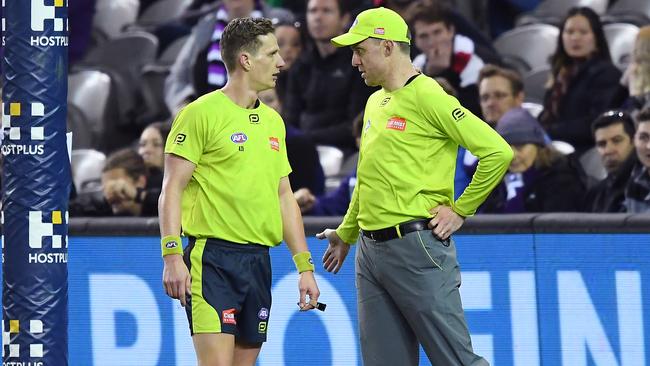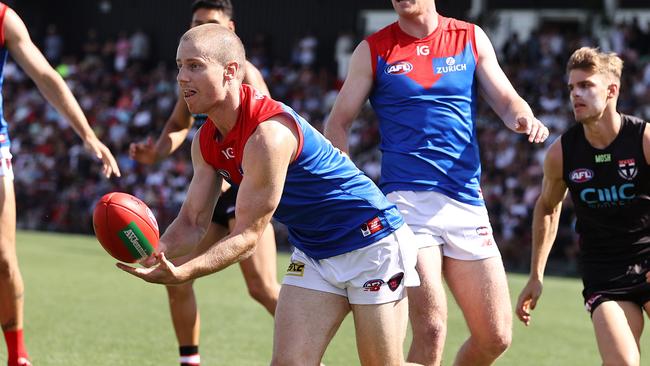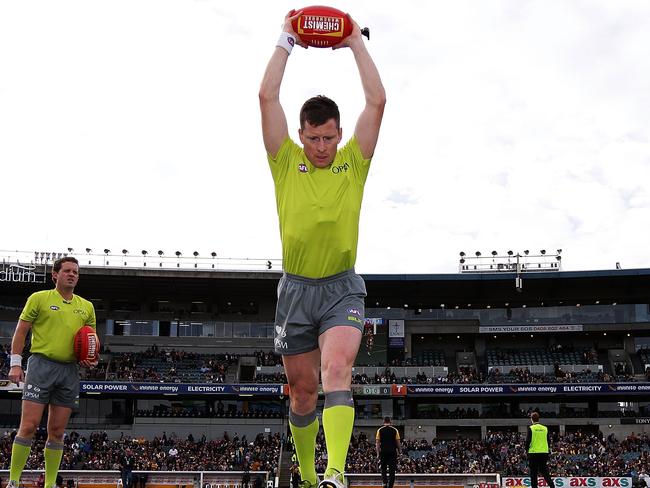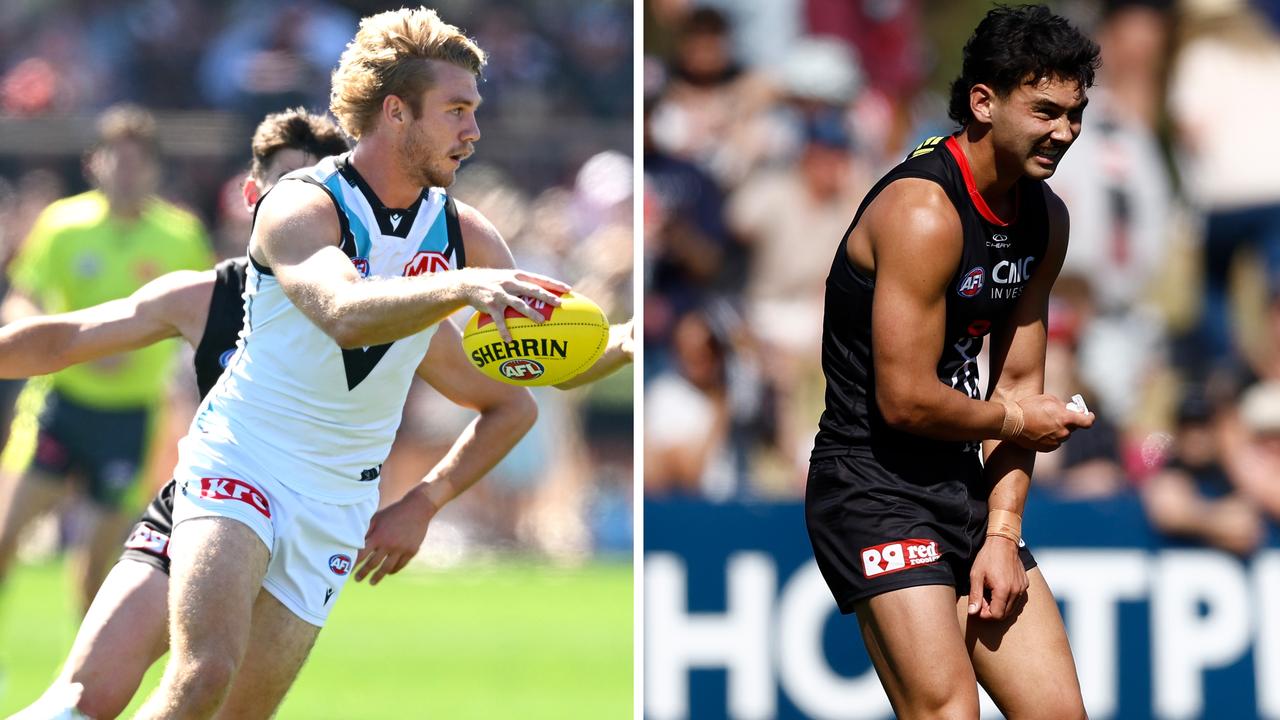AFL edges closer to microchip technology in footballs to introduce ball-tracking
The AFL is edging closer to testing NFL-style ball tracking technology in real games, and the impact will go far beyond fixing the goal review system.

AFL
Don't miss out on the headlines from AFL. Followed categories will be added to My News.
The AFL is edging closer to the introduction of microchip technology in footballs as it gets set to launch into the next critical phase of its trial into the ball-tracking innovation.
In what has been described as a “really significant” advancement for the game, the league has spent the past year testing the microchip technology in Sherrins as part of its plan to introduce ball tracking to the AFL.
Already in use in the NFL and soon to be trialled in world rugby, the technology has the potential to provide clarity on contentious umpiring decisions, offer unique game analysis and provide real-time information on ball movement to enhance the viewing experience for fans at home and in stadiums.
While the AFL has been buoyed by encouraging results in testing so far, it is yet to set a timeline on when the technology could feature in a match for premiership points.
Now up to its sixth Sherrin prototype with the embedded microchip technology, the league has conducted extensive lab tests on the ball and contained field trials last pre-season with the Carlton Football Club.

The league is now ready to begin wider trials of the technology in training sessions across clubs next pre-season and could be ready to test within games – perhaps initially in the Coates Talent League or VFL – next year.
But the AFL said it would not rush the technology’s introduction to the game and would only unveil it when it was “ready and accurate”.
“We are now in the second phase or iteration of the trial, which is to start to circulate it in training sessions and games in a more robust way,” the AFL’s acting general manager of football operations Laura Kane said.
“We are working through what the timeline is. It will take as long as it takes to be ready and accurate and able to be rolled out in a competition game for points.
“It is a really big deal. It’s the first time we’ve tracked the football, put a chip in the football and the first time we have looked at this type of technology in a really meaningful way.
“We track everything else, we have got cameras on goalposts. We have got 16 angles on broadcast but currently don’t track the thing that moves around the ground.
“International sports are doing it, the technology is used in different sports in such different ways, so we are excited to see what it can do for us.”
The league has been developing the microchip technology in conjunction with UK tech company Sportable, which partnered with manufacturer Gilbert to develop the rugby “smart ball”.
UK Sportable representatives have visited Australia to assist with the AFL’s testing of the Sherrin in the lab, and in the field.

HOW IT WORKS
The ball-tracking technology features a microchip inside the bladder of the ball, but it weighs and looks the same as a typical Sherrin football.
The only sign of the technology in the current ball is a very small incision as the access point for the microchip between the laces.
AFL umpires coaching, performance and innovation manager Damian Farrow has been heavily involved in the development of the ball and said all of the Sherrin’s unique characteristics had been retained.
“It looks, it smells, tastes like a footy and is the same weight as a real footy,” Farrow said.
“Basically if you think of the GPS units the players wear on their back, the ball is now wearing its own GPS unit in the bladder. That’s the simple way to think about it, it’s a similar technology.
“Like GPS, it has got what we call gyroscopes and accelerometers that can tell the spin rate of the ball and then in turn the distance the ball is travelling.
“Simply, it is a really lightweight chip or sensor inside the bladder of the ball.
“Part of the engineering behind it is to ensure the ball still flies in the same manner, so there is a counter weight in there as well to ensure it all behaves the way that it should like players are accustomed to.”
Early prototypes of the ball featured a rubber stopper at the top of the Sherrin where the data port was, but that is now all embedded and hidden.
Initially, the league faced some challenges in the early phases of testing with keeping the ball inflated, but is confident it has ironed out those issues after a year of development.
“The balls were challenged in terms of being able to stay inflated while our players kicked the ball,” Farrow said.
“They kick the ball with more force than what you would expect from, say, a rugby player.
“So there has been a host of challenges and that’s why it’s a long-term project to optimise it, so that it is reliable and robust.”

WHAT WILL IT BRING TO THE GAME?
The microchip technology has been discussed as a solution for contentious umpiring decisions, such as whether the ball has hit the post, or if it was out of bounds.
But the league said the applications for the technology were wide-reaching.
The technology is also set to enhance the viewing experience for fans as in-game data collected from the ball is streamed live to the big screen or the broadcast at home.
“The important overlay is around what information it can tell us, not just the clubs and the players, but also the fans,” Kane said.
“Both in stadium and on broadcast, what information can we provide to fans in real-time. That might be how long a torp is or how far away from the goal a set shot was.
“A couple of the key metrics we would like to know more about are things like ball speed and congestion. So, how many players are around the football or in proximity to the football and at the moment we assess all those metrics manually.
“(It could tell us) how quickly it is moving. We hear anecdotally about a fast game of footy or a fast brand of football, what does that actually mean – how fast is the football going?
“That’s what we are also really excited about – what information can we give to our fans in real time.”

The technology also has the potential to take player and game analysis to a new level by providing new information in the training environment.
“It can help with skill development and coaches being able to provide immediate feedback on the type of kick they are practising, so it is giving a piece of information that we haven’t had in the game before,” Farrow said.
“(When our players) were kicking at Carlton training, they wanted to rush over to the laptop that was set-up and look at how far they kicked and who had the longest kick and all those things.
“If you think like a club does about umpiring, for example, they love to know who is taking the centre bounces. Now they will know which umpires bounces at a certain height, what’s their signature bounce height?
“Which is how they think about their rucks and which ruck they want to play. It will be another tactical shift based on what they find.”

And the umpires are also set to benefit from the technology.
“We are hoping it will take a bit of stress out of it from an umpires’ point of view,” Farrow said.
“It’s just another source of information (for them). If you think about the goal face, it will be another source of information we can use to determine if the ball has hit the post or not hit the post. Going over the top of the post is a really challenging one for the umpires at the moment, so this will help them in that regard.
“Hopefully, it will be very positive for them.”
The AFL said information garnered from the technology would add another layer to its ARC system already in use to review close decisions.
Originally published as AFL edges closer to microchip technology in footballs to introduce ball-tracking



